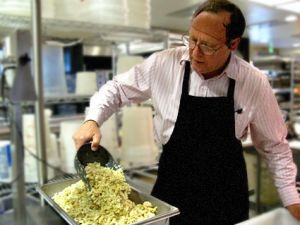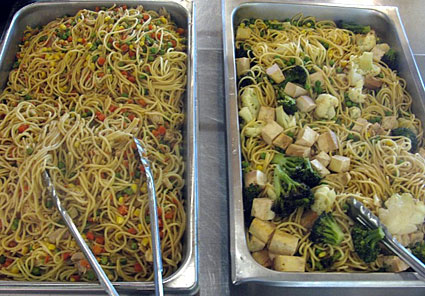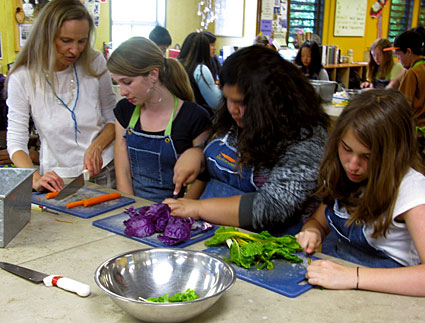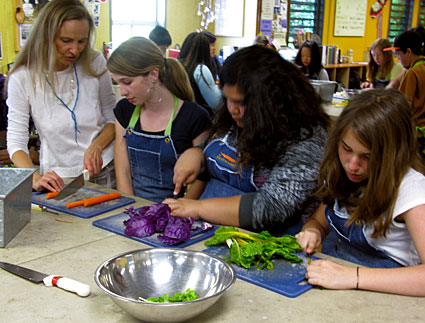Part 5 of Cafeteria Confidential: Berkeley, in which Ed Bruske reports on his recent week-long, firsthand look at how Berkeley, Calif., schools part ways from the typical school diet of frozen, industrially processed convenience foods. Cross-posted from The Slow Cook. And check out the rest of the Cafeteria Confidential series.
After spending hours sorting chicken pieces during my first day on the job in the Berkeley school system’s central kitchen, I got a break.
“How would you like to serve the kids at lunch?” asked Joan Gallagher, the sous chef in charge of kitchen production. “It’s the most exciting part of the day. You’ll get to interact with the kids.”
I would soon learn that interactions with middle-schoolers over lunch food can test your nerves.
The not-so-magical fruit
My assignment was to scoop beans at one of two pizza stations in the “Dining Commons” at Martin Luther King, Jr. Middle School. About 1,000 kids attend the school. They descend on the Commons in three waves, beginning at 11:25 am. First they check in at one of two cashiers, where they punch a personalized, four-digit number on a small keypad that identifies them as either a free, reduced-price, or pay-in-full customer. They get a ticket they’re supposed to deposit in a plastic bucket when they pick up their food. And they grab a tray, a reusable plastic dinner plate, and silverware.
 The author, in hair net, scooping pastaThere are four food stations in all. In middle school, kids get a choice of two entrees; elementary school kids get only one. The other choice on Mondays is a taco with beans and rice.
The author, in hair net, scooping pastaThere are four food stations in all. In middle school, kids get a choice of two entrees; elementary school kids get only one. The other choice on Mondays is a taco with beans and rice.
The pizza produced in the central kitchen is quite good. In addition to canned tomatoes, the marinara sauce for the red pizza is loaded with vegetables: 125 pounds of celery, carrot, onion and garlic to be precise, all cooked in a giant kettle. The sausage pizza is topped with homemade turkey sausage. And a third variety — my favorite — is slathered with pesto.
In the district’s elementary schools, the pizza is made on rectangular baking sheets using a whole-wheat crust from a local bakery, FullBloom. Middle schoolers get something quite different: a round pizza that’s also made with a whole-wheat crust, but from an institutional supplier, Sysco. The reason? “By the time they get to middle school, kids are already very brand- or package-conscious,” says Executive Chef Bonnie Christensen. “They want round pizza.”
They had their ideas about beans, too, even the gorgeous, plump cannellini beans in a Tuscan-style salad that I was serving with an ice-cream scoop to go with the pizza. Basically, they didn’t want the beans.
“No beans!” I heard as plate after plate was thrust in our direction, demanding a slice of pizza. “No beans!” “No beans!”
Government regulations require that a certain quantity of vegetables or fruits be offered with school meals, along with meat, or meat alternative, and grains. The emphasis is on the word “offered,” because the kids can take what they want, as long as they take three of the items provided. If they don’t, what they do take doesn’t qualify as a “meal” and won’t be credited for purposes of the federal subsidies the school receives to pay for the food.
So how hard should I push the beans, which count as a vegetable? There was also a big bowl of oranges and apples at our station. The kids could take one of those. Or they could serve themselves a salad at the salad bar a few yards away. In most schools, the kids fill their plates in the food line before they get to the cashier. The unusual arrangement in Berkeley’s “dining commons” is deliberately more open and less institutional, suggesting an actual dining experience rather than a cattle call. But it does inject a bit of uncertainty. How were we supposed to kow what the kids did after they left our station if all they had on their plate was a slice of pizza and no beans?
Next to me was one of the regular servers, Joyce, who was handing out the pizza. She urged me not to push the beans too hard. “We want to be friends with the older kids,” she whispered. When I described to Christensen the uncertainty I was experiencing — the sense I got from Joyce that maybe I shouldn’t antagonize the kids by making them take beans they didn’t want — the executive chef didn’t flinch. “I antagonize them,” she said jokingly.
By the end of the week, I had a pat answer for kids who said they didn’t want the beans: “The federal government says you must have beans,” I’d say after grabbing their plate and dropping a scoop of Tuscan bean salad on it. Quickly followed by: “You don’t have to eat them if you don’t want to.”
The kids looked at me like I’d landed from Mars. I could see how this would get old fast.
 Berkeley schools’ homemade lo mein hides lots of vegetables … just not well enough.(Ed Bruske)In fact, a quick tour around the dining hall told me the kids weren’t eating many beans. Mostly they scraped the beans into a compost receptacle at the end of the meal. On Wednesday — pasta day in Berkeley schools — I would confront this issue again when I was asked to man a station serving two kinds of lo mein. One was made with diced chicken and a mix of diced carrots, peas, and corn. A second vegetarian option had tofu with roasted broccoli and cauliflower.
Berkeley schools’ homemade lo mein hides lots of vegetables … just not well enough.(Ed Bruske)In fact, a quick tour around the dining hall told me the kids weren’t eating many beans. Mostly they scraped the beans into a compost receptacle at the end of the meal. On Wednesday — pasta day in Berkeley schools — I would confront this issue again when I was asked to man a station serving two kinds of lo mein. One was made with diced chicken and a mix of diced carrots, peas, and corn. A second vegetarian option had tofu with roasted broccoli and cauliflower.
The “lo mein” was really spaghetti noodles tossed with the other ingredients and a light Asian sauce. The vegetables in the chicken version in particular just wanted to sink to the bottom of the pan and disappear under the noodles. Kids who opted for the chicken lo mein frequently added “no vegetables” to their request. I would give them vegetables anyway. That seemed to irritate them. I would get an icy stare. One girl in particular got angry. I guess I misheard her, because I thought she said she wanted the vegetables. I did my best to find some with my spring-loaded tongs and lift them onto her plate. Finally she stomped her foot and sneered, “I said, no vegetables!”
Yikes.
I was getting the impression that kids in Berkeley weren’t really much different from kids everywhere. In most cafeterias I’ve visited — I sit in on meals at my daughter’s school almost every day — kids generally reject vegetables.
In District of Columbia schools, as in most places, these are canned green beans, or steamed carrots, or broccoli steamed until it disintegrates. The serving trays dressed with these limp vegetable side dishes look like a clumsy attempt to comply with federal regulations, no more. The kids typically don’t touch the vegetables and just throw them in the trash. In fact, the drafters of “Healthy Schools” legislation in D.C. had planned to adopt newly proposed school meal standards from the Institute of Medicine that call for increased portions of vegetables. But local school officials begged them not to, saying there was no way the schools could prepare additional vegetables kids would actually eat. It would just be money down the drain.
Until five years ago, meals in Berkeley schools were served much the same way. Vegetables were canned or frozen. Fruit came in a can, in a bath of sugary syrup. But you won’t see vegetables served as “sides” in Berkeley these days. There are no steamed carrots.
“Kids don’t like carrots,” Gallagher says. And no steamed broccoli. “Steaming removes the nutrients from vegetables,” says Christensen. Instead, broccoli and other vegetables are more often roasted. Not only does roasting not leach out nutrients, it enhances the color and flavor of vegetables. “Roasting vegetables definitely is the way to go,” she says.
That may just sum up the difference between a kitchen run by professional chefs and the majority of school kitchens that cook out of freezers.
Berkeley schools are now equipped with salad bars from which kids can help themselves. The week I was there, the salad bar in the Dining Commons offered romaine lettuce, white beans, cottage cheese, chopped hard-boiled eggs, raw jicama slices, sliced radishes, pickled jalapeño slices, roasted potato wedges, sliced carrots, chickpeas, raw cauliflower and broccoli, hummus, corn, and and types of dressing.
According to “Lunch Matters,” a 2008 report published by the Chez Panisse Foundation, lunch participation among students who qualify for either free or reduced-price meals increased to more than 50 percent at one Berkeley middle school after a salad bar was installed. The school district employs special part-time workers to maintain the salad bars. During my week in the central kitchen, I did not see kids exactly attacking the salad bar. I asked Christensen if it was safe to say that kids just don’t like to eat vegetables. Why go to all the trouble to source and prepare fresh vegetables if children are just going to turn up their nose at them?
Christensen stood firm. “Are they eating white beans? No,” she says. “But they know what blood oranges are. It’s an incremental process, and I’ll take incremental progress.”
While it’s also true that middle school students do not tend to go to the salad bar, according to Christensen, they do in the elementary schools, where they get “a lot more encouragement and guidance.”
As far as eating other vegetables, “you can’t force feed them. All we can do is expose them and only give them good choices.” Kids might not eat the vegetables now, she says, “but if they feel what it’s like to be nourished, then later, when they’re on their own and spending their own money, they’ll make different choices. We’re trying to teach them what it’s like to eat healthy food. We’re not going to see results overnight.”
In fact, Berkeley schools can’t afford to spend money and labor on food that won’t be eaten. “The quality of the ingredients is so much better than it used to be, and they’re perishable, so they cost more,” Christensen explains. (Fresh vegetables are “regionally sourced” and organic “to the maximum extent possible”; see accompanying article on how Berkeley sources its food.)
Rather than being served as separate side dishes the students might reject, vegetabales are incorporated into school meals in other ways, such as the lo mein or the 125 pounds of onions, carrots, celery, and garlic that go into the marinara sauce. “I make things like tabouleh, white beans with braised collard greens, vegetable stir fry, vegetables in the chicken cacciatore, in the garlic-bacon pasta,” Christensen says. “There’s a ton of vegetables in the meat loaf and the shepherd’s pie, and we make stir-fried rice with lots of vegetables.” There are also vegetables in the soup, offered daily.
A culinary education
The chefs visit classes on Thursdays for something called “What’s on Your Plate,” where they talk to students about the food that’s being served. Gallagher, the sous chef, says the students might not accept some foods at all without these sessions. Tandoori chicken, made from a recipe handed down by Christensen’s mother, is one example. It’s roasted after being coated with a yogurt marinade. The finished chicken has a rustic — some might say “gnarly” — appearance that can, and has, put kids off.
In “What’s on Your Plate,” the students get to taste the food and offer comments. “They write their comments on individual pieces of paper and the teachers send them back to us,” says Christensen. “I love these! You’d be impressed with what the children have to say when prompted for a thoughtful response.”
On some issues, however, the kids won’t budge. They drew the line with nachos.
In the old days, nachos — “chips in a boat with that big cheese stuff poured over the top and jalapeños” — were served every couple of days, Cooper recalls. “I looked at it and took it off the menu. The kids went on strike. They said they weren’t going to eat there and they stopped coming in for lunch.” Since then, nachos are served every Friday. They’re just different nachos: no more gobs of melted cheese — meat, beans, rice and grated cheese instead. “Nobody wants to fight that battle,” Gallagher shrugs. “It’s Friday.”
 Berkeley middle schoolers prep vegetables for stir fry in an Edible Schoolyard classroom.(Ed Bruske)Across the playground and up the hill from the dining commons is the Edible Schoolyard, founded by Alice Waters, where students rotate in and out of 1.5-hour classes over the course of the year, working in the garden and taking cooking lessons in the garden’s kitchen. The idea is to familiarize children with where food comes from, and to teach the importance of a healthful diet and a respectful approach toward eating.
Berkeley middle schoolers prep vegetables for stir fry in an Edible Schoolyard classroom.(Ed Bruske)Across the playground and up the hill from the dining commons is the Edible Schoolyard, founded by Alice Waters, where students rotate in and out of 1.5-hour classes over the course of the year, working in the garden and taking cooking lessons in the garden’s kitchen. The idea is to familiarize children with where food comes from, and to teach the importance of a healthful diet and a respectful approach toward eating.
I sat in on one of the cooking classes, in which middle-schoolers made their own tofu-and-vegetable stir fry. The kitchen is remarkably well-equipped, with three long tables set at an ideal height for chopping, three stations with sinks and electric burners, individual cuttting boards and knives for all the students, vegetable peelers, zesters, a freestanding convection oven turning out an impeccable strawberry gallette, and at the other end of the room, a commercial-grade dishwashing area.
Just like in my own cooking classes at a private elementary school here in D.C., these kids had a ball. They ernestly chopped vegetables and couldn’t wait for a turn cooking in woks. When the cooking was done, they cleared the tables and spread checkered tablecloths on which they set plates, silverware, and glasses. Alice Waters would have been proud.
The Dr. Robert C. & Veronica Atkins Center for Weight and Health at UC Berkeley has been monitoring elementary-school children in Berkeley to see if the gardening and food lessons have increased their appetite for fruits and vegetables, both at home and at school. University students venture into the field to photograph kids’ plates in cafeterias, administer questionnaires, and cull information from food diaries. The results so far: kids who get the extra exposure to gardens and food preparation tend to be more receptive to eating produce … but not by much.
According to that research, kids are more likely to say they like vegetables “a little” than “a lot.” Those who garden give higher marks to these: asparagus, squash, carrots, sweet potatoes, and tomatoes. Updated results from this ongoing study are expected to be released later this month.
After spending a week in Waters’ back yard, I wondered what she thought about the food her movement has inspired in the Berkeley schools. Had she ever visited the Dining Commons?
I sent my questions to an aide at the Chez Panisse Foundation. Waters, the aide replied in an e-mail, “is interested in a complete re-imagination of a school lunch program, one that — among other things — could help educate the students with dishes that teach them about different cultures and ingredients. Of course she is certainly thrilled that real and fresh ingredients have replaced processed foods — this is a major piece of the puzzle — but she is hoping to take that even further by evolving menus.” And yes, Waters has eaten in the dining commons “on a number of occasions,” the aide said.
I wonder if she tried the beans.
Next: The truth about kids and vegetables



